Individual Essay: Exploring Equity and Job Satisfaction in OB
VerifiedAdded on 2023/01/05
|10
|2639
|2
Essay
AI Summary
This essay provides an in-depth analysis of two key organizational behaviour theories: equity theory and job satisfaction. The introduction sets the stage by defining organizational behaviour and its significance, then introduces the chosen theories. The essay delves into equity theory, examining how fairness in resource distribution impacts employee motivation and performance, including its advantages and disadvantages. It then explores job satisfaction, defining it as an employee's contentment with their role, highlighting its importance from both employee and employer perspectives, along with its pros and cons. A comparative analysis highlights the interconnectedness of the two theories, demonstrating how equity influences job satisfaction and ultimately, employee performance. The conclusion emphasizes the importance of organizational behaviour theories for fostering a positive work environment, employee motivation, and organizational success.

ORGANISATIONAL BEHAVIOUR
Paraphrase This Document
Need a fresh take? Get an instant paraphrase of this document with our AI Paraphraser

ORGANISATIONAL BEHAVIOUR 1
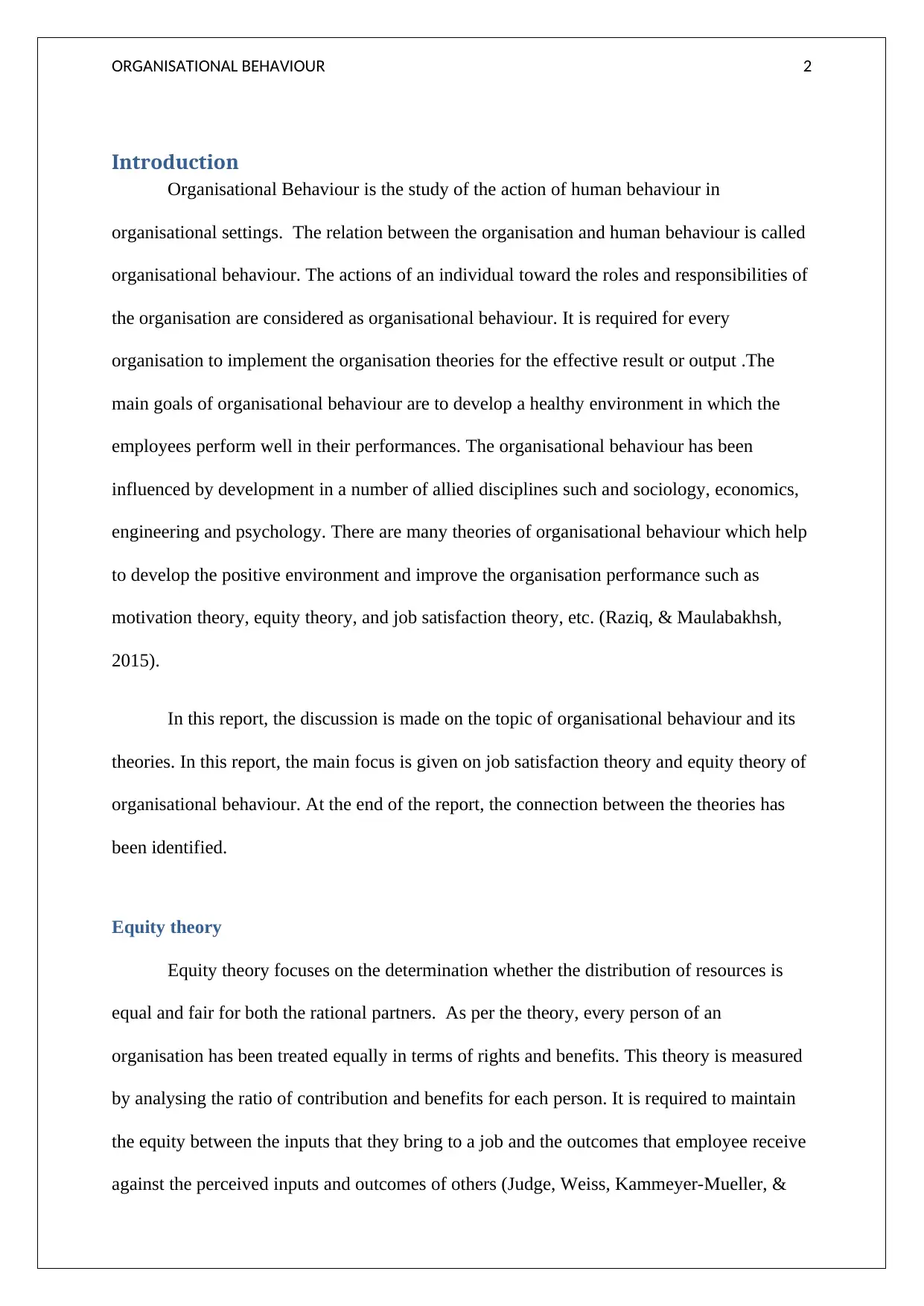
ORGANISATIONAL BEHAVIOUR 2
Introduction
Organisational Behaviour is the study of the action of human behaviour in
organisational settings. The relation between the organisation and human behaviour is called
organisational behaviour. The actions of an individual toward the roles and responsibilities of
the organisation are considered as organisational behaviour. It is required for every
organisation to implement the organisation theories for the effective result or output .The
main goals of organisational behaviour are to develop a healthy environment in which the
employees perform well in their performances. The organisational behaviour has been
influenced by development in a number of allied disciplines such and sociology, economics,
engineering and psychology. There are many theories of organisational behaviour which help
to develop the positive environment and improve the organisation performance such as
motivation theory, equity theory, and job satisfaction theory, etc. (Raziq, & Maulabakhsh,
2015).
In this report, the discussion is made on the topic of organisational behaviour and its
theories. In this report, the main focus is given on job satisfaction theory and equity theory of
organisational behaviour. At the end of the report, the connection between the theories has
been identified.
Equity theory
Equity theory focuses on the determination whether the distribution of resources is
equal and fair for both the rational partners. As per the theory, every person of an
organisation has been treated equally in terms of rights and benefits. This theory is measured
by analysing the ratio of contribution and benefits for each person. It is required to maintain
the equity between the inputs that they bring to a job and the outcomes that employee receive
against the perceived inputs and outcomes of others (Judge, Weiss, Kammeyer-Mueller, &
Introduction
Organisational Behaviour is the study of the action of human behaviour in
organisational settings. The relation between the organisation and human behaviour is called
organisational behaviour. The actions of an individual toward the roles and responsibilities of
the organisation are considered as organisational behaviour. It is required for every
organisation to implement the organisation theories for the effective result or output .The
main goals of organisational behaviour are to develop a healthy environment in which the
employees perform well in their performances. The organisational behaviour has been
influenced by development in a number of allied disciplines such and sociology, economics,
engineering and psychology. There are many theories of organisational behaviour which help
to develop the positive environment and improve the organisation performance such as
motivation theory, equity theory, and job satisfaction theory, etc. (Raziq, & Maulabakhsh,
2015).
In this report, the discussion is made on the topic of organisational behaviour and its
theories. In this report, the main focus is given on job satisfaction theory and equity theory of
organisational behaviour. At the end of the report, the connection between the theories has
been identified.
Equity theory
Equity theory focuses on the determination whether the distribution of resources is
equal and fair for both the rational partners. As per the theory, every person of an
organisation has been treated equally in terms of rights and benefits. This theory is measured
by analysing the ratio of contribution and benefits for each person. It is required to maintain
the equity between the inputs that they bring to a job and the outcomes that employee receive
against the perceived inputs and outcomes of others (Judge, Weiss, Kammeyer-Mueller, &
⊘ This is a preview!⊘
Do you want full access?
Subscribe today to unlock all pages.

Trusted by 1+ million students worldwide
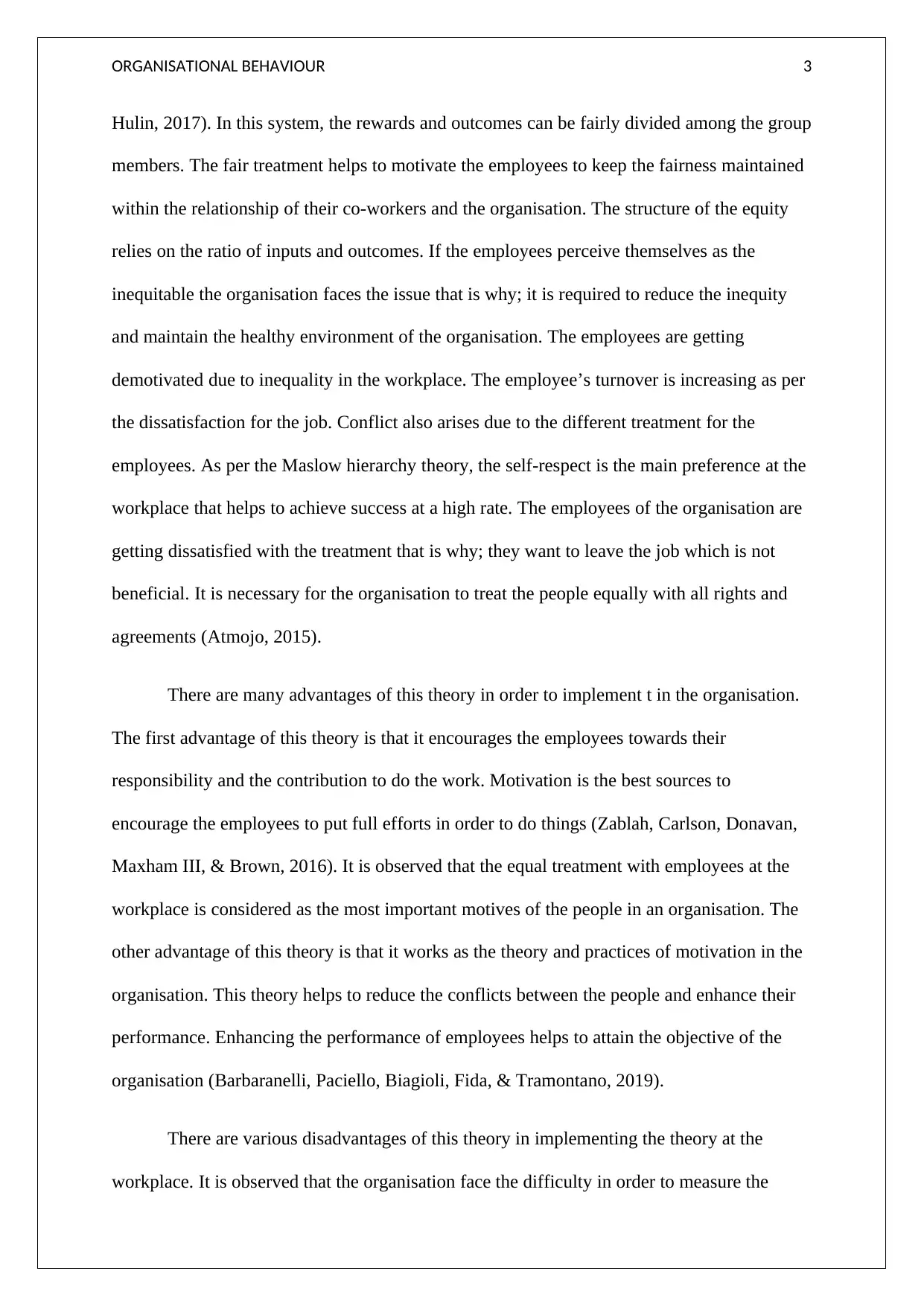
ORGANISATIONAL BEHAVIOUR 3
Hulin, 2017). In this system, the rewards and outcomes can be fairly divided among the group
members. The fair treatment helps to motivate the employees to keep the fairness maintained
within the relationship of their co-workers and the organisation. The structure of the equity
relies on the ratio of inputs and outcomes. If the employees perceive themselves as the
inequitable the organisation faces the issue that is why; it is required to reduce the inequity
and maintain the healthy environment of the organisation. The employees are getting
demotivated due to inequality in the workplace. The employee’s turnover is increasing as per
the dissatisfaction for the job. Conflict also arises due to the different treatment for the
employees. As per the Maslow hierarchy theory, the self-respect is the main preference at the
workplace that helps to achieve success at a high rate. The employees of the organisation are
getting dissatisfied with the treatment that is why; they want to leave the job which is not
beneficial. It is necessary for the organisation to treat the people equally with all rights and
agreements (Atmojo, 2015).
There are many advantages of this theory in order to implement t in the organisation.
The first advantage of this theory is that it encourages the employees towards their
responsibility and the contribution to do the work. Motivation is the best sources to
encourage the employees to put full efforts in order to do things (Zablah, Carlson, Donavan,
Maxham III, & Brown, 2016). It is observed that the equal treatment with employees at the
workplace is considered as the most important motives of the people in an organisation. The
other advantage of this theory is that it works as the theory and practices of motivation in the
organisation. This theory helps to reduce the conflicts between the people and enhance their
performance. Enhancing the performance of employees helps to attain the objective of the
organisation (Barbaranelli, Paciello, Biagioli, Fida, & Tramontano, 2019).
There are various disadvantages of this theory in implementing the theory at the
workplace. It is observed that the organisation face the difficulty in order to measure the
Hulin, 2017). In this system, the rewards and outcomes can be fairly divided among the group
members. The fair treatment helps to motivate the employees to keep the fairness maintained
within the relationship of their co-workers and the organisation. The structure of the equity
relies on the ratio of inputs and outcomes. If the employees perceive themselves as the
inequitable the organisation faces the issue that is why; it is required to reduce the inequity
and maintain the healthy environment of the organisation. The employees are getting
demotivated due to inequality in the workplace. The employee’s turnover is increasing as per
the dissatisfaction for the job. Conflict also arises due to the different treatment for the
employees. As per the Maslow hierarchy theory, the self-respect is the main preference at the
workplace that helps to achieve success at a high rate. The employees of the organisation are
getting dissatisfied with the treatment that is why; they want to leave the job which is not
beneficial. It is necessary for the organisation to treat the people equally with all rights and
agreements (Atmojo, 2015).
There are many advantages of this theory in order to implement t in the organisation.
The first advantage of this theory is that it encourages the employees towards their
responsibility and the contribution to do the work. Motivation is the best sources to
encourage the employees to put full efforts in order to do things (Zablah, Carlson, Donavan,
Maxham III, & Brown, 2016). It is observed that the equal treatment with employees at the
workplace is considered as the most important motives of the people in an organisation. The
other advantage of this theory is that it works as the theory and practices of motivation in the
organisation. This theory helps to reduce the conflicts between the people and enhance their
performance. Enhancing the performance of employees helps to attain the objective of the
organisation (Barbaranelli, Paciello, Biagioli, Fida, & Tramontano, 2019).
There are various disadvantages of this theory in implementing the theory at the
workplace. It is observed that the organisation face the difficulty in order to measure the
Paraphrase This Document
Need a fresh take? Get an instant paraphrase of this document with our AI Paraphraser
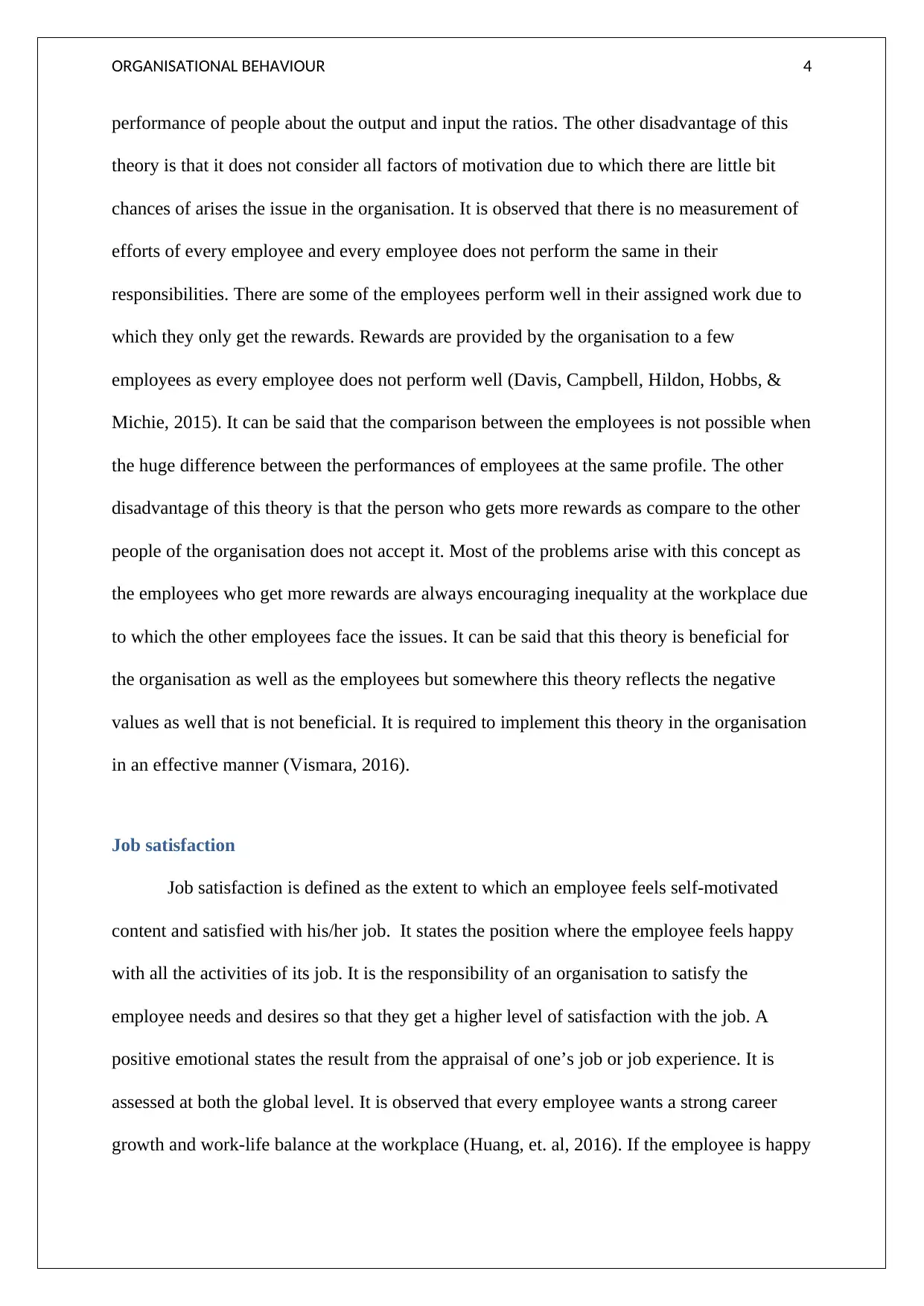
ORGANISATIONAL BEHAVIOUR 4
performance of people about the output and input the ratios. The other disadvantage of this
theory is that it does not consider all factors of motivation due to which there are little bit
chances of arises the issue in the organisation. It is observed that there is no measurement of
efforts of every employee and every employee does not perform the same in their
responsibilities. There are some of the employees perform well in their assigned work due to
which they only get the rewards. Rewards are provided by the organisation to a few
employees as every employee does not perform well (Davis, Campbell, Hildon, Hobbs, &
Michie, 2015). It can be said that the comparison between the employees is not possible when
the huge difference between the performances of employees at the same profile. The other
disadvantage of this theory is that the person who gets more rewards as compare to the other
people of the organisation does not accept it. Most of the problems arise with this concept as
the employees who get more rewards are always encouraging inequality at the workplace due
to which the other employees face the issues. It can be said that this theory is beneficial for
the organisation as well as the employees but somewhere this theory reflects the negative
values as well that is not beneficial. It is required to implement this theory in the organisation
in an effective manner (Vismara, 2016).
Job satisfaction
Job satisfaction is defined as the extent to which an employee feels self-motivated
content and satisfied with his/her job. It states the position where the employee feels happy
with all the activities of its job. It is the responsibility of an organisation to satisfy the
employee needs and desires so that they get a higher level of satisfaction with the job. A
positive emotional states the result from the appraisal of one’s job or job experience. It is
assessed at both the global level. It is observed that every employee wants a strong career
growth and work-life balance at the workplace (Huang, et. al, 2016). If the employee is happy
performance of people about the output and input the ratios. The other disadvantage of this
theory is that it does not consider all factors of motivation due to which there are little bit
chances of arises the issue in the organisation. It is observed that there is no measurement of
efforts of every employee and every employee does not perform the same in their
responsibilities. There are some of the employees perform well in their assigned work due to
which they only get the rewards. Rewards are provided by the organisation to a few
employees as every employee does not perform well (Davis, Campbell, Hildon, Hobbs, &
Michie, 2015). It can be said that the comparison between the employees is not possible when
the huge difference between the performances of employees at the same profile. The other
disadvantage of this theory is that the person who gets more rewards as compare to the other
people of the organisation does not accept it. Most of the problems arise with this concept as
the employees who get more rewards are always encouraging inequality at the workplace due
to which the other employees face the issues. It can be said that this theory is beneficial for
the organisation as well as the employees but somewhere this theory reflects the negative
values as well that is not beneficial. It is required to implement this theory in the organisation
in an effective manner (Vismara, 2016).
Job satisfaction
Job satisfaction is defined as the extent to which an employee feels self-motivated
content and satisfied with his/her job. It states the position where the employee feels happy
with all the activities of its job. It is the responsibility of an organisation to satisfy the
employee needs and desires so that they get a higher level of satisfaction with the job. A
positive emotional states the result from the appraisal of one’s job or job experience. It is
assessed at both the global level. It is observed that every employee wants a strong career
growth and work-life balance at the workplace (Huang, et. al, 2016). If the employee is happy
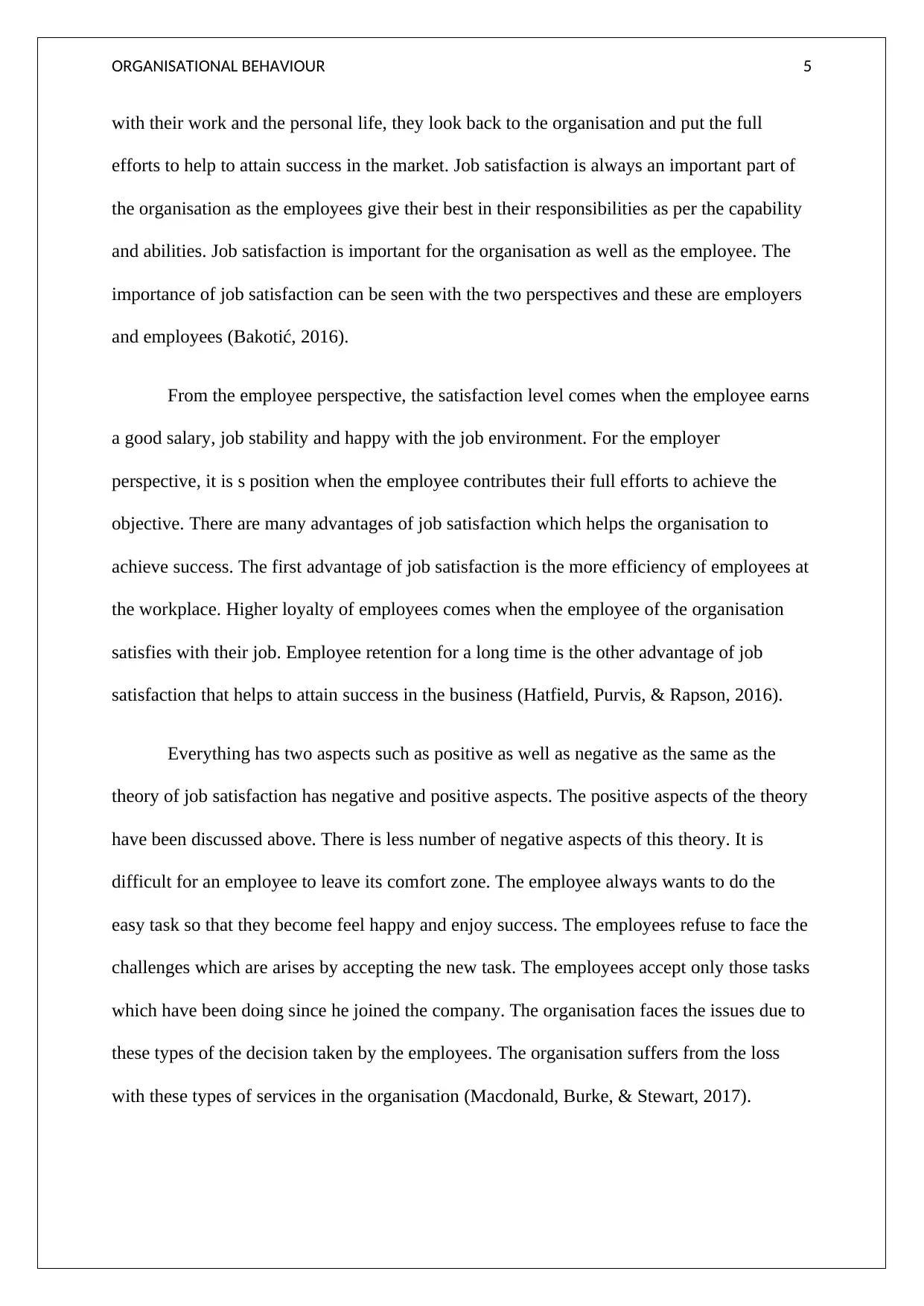
ORGANISATIONAL BEHAVIOUR 5
with their work and the personal life, they look back to the organisation and put the full
efforts to help to attain success in the market. Job satisfaction is always an important part of
the organisation as the employees give their best in their responsibilities as per the capability
and abilities. Job satisfaction is important for the organisation as well as the employee. The
importance of job satisfaction can be seen with the two perspectives and these are employers
and employees (Bakotić, 2016).
From the employee perspective, the satisfaction level comes when the employee earns
a good salary, job stability and happy with the job environment. For the employer
perspective, it is s position when the employee contributes their full efforts to achieve the
objective. There are many advantages of job satisfaction which helps the organisation to
achieve success. The first advantage of job satisfaction is the more efficiency of employees at
the workplace. Higher loyalty of employees comes when the employee of the organisation
satisfies with their job. Employee retention for a long time is the other advantage of job
satisfaction that helps to attain success in the business (Hatfield, Purvis, & Rapson, 2016).
Everything has two aspects such as positive as well as negative as the same as the
theory of job satisfaction has negative and positive aspects. The positive aspects of the theory
have been discussed above. There is less number of negative aspects of this theory. It is
difficult for an employee to leave its comfort zone. The employee always wants to do the
easy task so that they become feel happy and enjoy success. The employees refuse to face the
challenges which are arises by accepting the new task. The employees accept only those tasks
which have been doing since he joined the company. The organisation faces the issues due to
these types of the decision taken by the employees. The organisation suffers from the loss
with these types of services in the organisation (Macdonald, Burke, & Stewart, 2017).
with their work and the personal life, they look back to the organisation and put the full
efforts to help to attain success in the market. Job satisfaction is always an important part of
the organisation as the employees give their best in their responsibilities as per the capability
and abilities. Job satisfaction is important for the organisation as well as the employee. The
importance of job satisfaction can be seen with the two perspectives and these are employers
and employees (Bakotić, 2016).
From the employee perspective, the satisfaction level comes when the employee earns
a good salary, job stability and happy with the job environment. For the employer
perspective, it is s position when the employee contributes their full efforts to achieve the
objective. There are many advantages of job satisfaction which helps the organisation to
achieve success. The first advantage of job satisfaction is the more efficiency of employees at
the workplace. Higher loyalty of employees comes when the employee of the organisation
satisfies with their job. Employee retention for a long time is the other advantage of job
satisfaction that helps to attain success in the business (Hatfield, Purvis, & Rapson, 2016).
Everything has two aspects such as positive as well as negative as the same as the
theory of job satisfaction has negative and positive aspects. The positive aspects of the theory
have been discussed above. There is less number of negative aspects of this theory. It is
difficult for an employee to leave its comfort zone. The employee always wants to do the
easy task so that they become feel happy and enjoy success. The employees refuse to face the
challenges which are arises by accepting the new task. The employees accept only those tasks
which have been doing since he joined the company. The organisation faces the issues due to
these types of the decision taken by the employees. The organisation suffers from the loss
with these types of services in the organisation (Macdonald, Burke, & Stewart, 2017).
⊘ This is a preview!⊘
Do you want full access?
Subscribe today to unlock all pages.

Trusted by 1+ million students worldwide
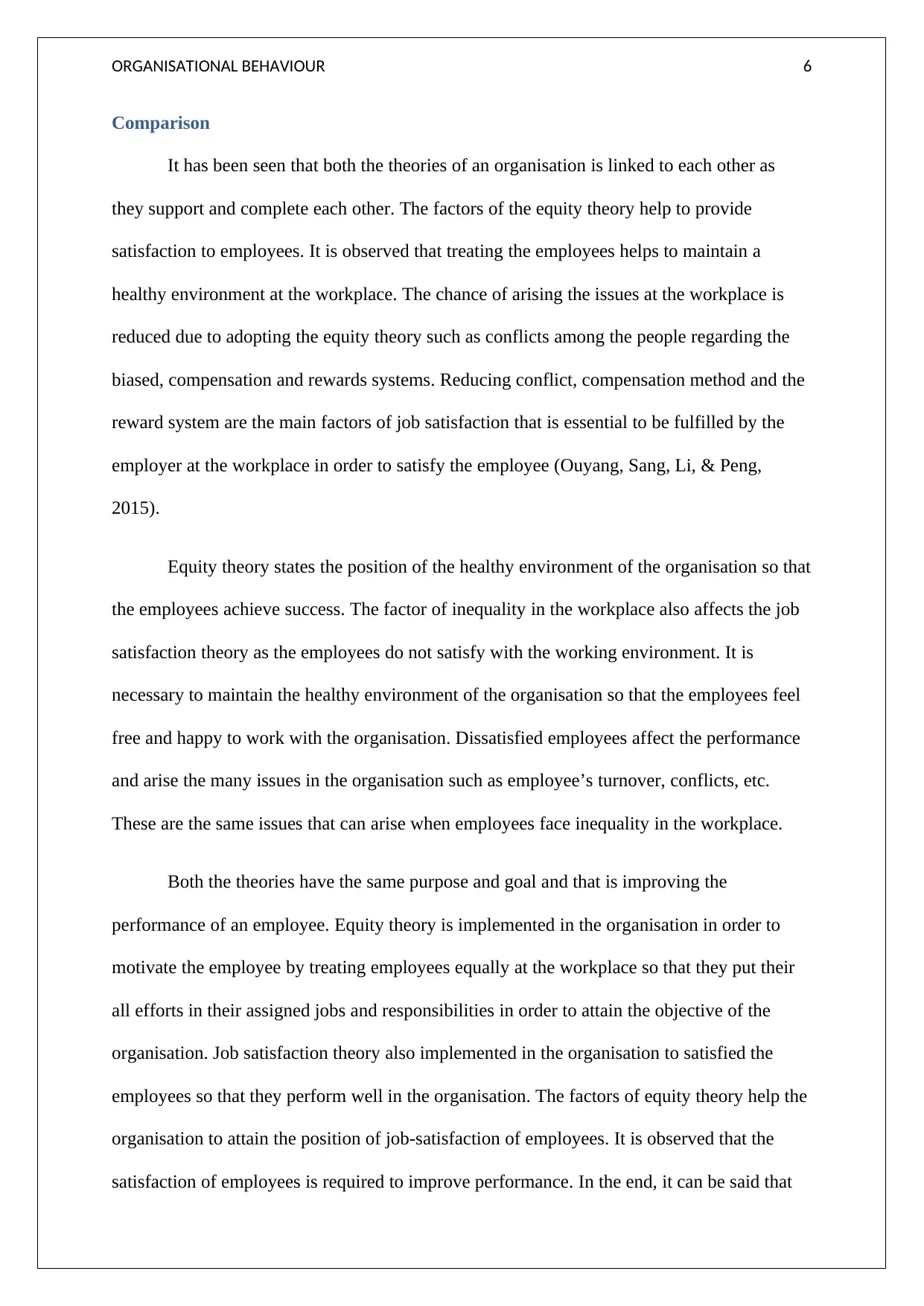
ORGANISATIONAL BEHAVIOUR 6
Comparison
It has been seen that both the theories of an organisation is linked to each other as
they support and complete each other. The factors of the equity theory help to provide
satisfaction to employees. It is observed that treating the employees helps to maintain a
healthy environment at the workplace. The chance of arising the issues at the workplace is
reduced due to adopting the equity theory such as conflicts among the people regarding the
biased, compensation and rewards systems. Reducing conflict, compensation method and the
reward system are the main factors of job satisfaction that is essential to be fulfilled by the
employer at the workplace in order to satisfy the employee (Ouyang, Sang, Li, & Peng,
2015).
Equity theory states the position of the healthy environment of the organisation so that
the employees achieve success. The factor of inequality in the workplace also affects the job
satisfaction theory as the employees do not satisfy with the working environment. It is
necessary to maintain the healthy environment of the organisation so that the employees feel
free and happy to work with the organisation. Dissatisfied employees affect the performance
and arise the many issues in the organisation such as employee’s turnover, conflicts, etc.
These are the same issues that can arise when employees face inequality in the workplace.
Both the theories have the same purpose and goal and that is improving the
performance of an employee. Equity theory is implemented in the organisation in order to
motivate the employee by treating employees equally at the workplace so that they put their
all efforts in their assigned jobs and responsibilities in order to attain the objective of the
organisation. Job satisfaction theory also implemented in the organisation to satisfied the
employees so that they perform well in the organisation. The factors of equity theory help the
organisation to attain the position of job-satisfaction of employees. It is observed that the
satisfaction of employees is required to improve performance. In the end, it can be said that
Comparison
It has been seen that both the theories of an organisation is linked to each other as
they support and complete each other. The factors of the equity theory help to provide
satisfaction to employees. It is observed that treating the employees helps to maintain a
healthy environment at the workplace. The chance of arising the issues at the workplace is
reduced due to adopting the equity theory such as conflicts among the people regarding the
biased, compensation and rewards systems. Reducing conflict, compensation method and the
reward system are the main factors of job satisfaction that is essential to be fulfilled by the
employer at the workplace in order to satisfy the employee (Ouyang, Sang, Li, & Peng,
2015).
Equity theory states the position of the healthy environment of the organisation so that
the employees achieve success. The factor of inequality in the workplace also affects the job
satisfaction theory as the employees do not satisfy with the working environment. It is
necessary to maintain the healthy environment of the organisation so that the employees feel
free and happy to work with the organisation. Dissatisfied employees affect the performance
and arise the many issues in the organisation such as employee’s turnover, conflicts, etc.
These are the same issues that can arise when employees face inequality in the workplace.
Both the theories have the same purpose and goal and that is improving the
performance of an employee. Equity theory is implemented in the organisation in order to
motivate the employee by treating employees equally at the workplace so that they put their
all efforts in their assigned jobs and responsibilities in order to attain the objective of the
organisation. Job satisfaction theory also implemented in the organisation to satisfied the
employees so that they perform well in the organisation. The factors of equity theory help the
organisation to attain the position of job-satisfaction of employees. It is observed that the
satisfaction of employees is required to improve performance. In the end, it can be said that
Paraphrase This Document
Need a fresh take? Get an instant paraphrase of this document with our AI Paraphraser

ORGANISATIONAL BEHAVIOUR 7
both the theories helps the organisation to attain the high success by improving the
performances of employees through treating them equal and satisfied their needs and desires
(Yousef, 2017).
Conclusion
At the end, it is concluded that the organisational behaviour theory of an organisation
is essential to implement at the workplace. In this report, the discussion is made on the equity
theory and job satisfaction theory. Equity theory is essential for the organisation in terms of
motivation by treating the people equal at the workplace. Job satisfaction is also necessary for
the organisation in order to enhance the performance of employees. Both theories support
each other as the factors and issues arise from the lack of their presence at the workplace. It is
observed that both theories are related to human behaviour. The objectives of these theories
are also similar and that is to improve the performance of an employee towards their
responsibilities. At the end, both the theories are essential for the organisation as well as for
complete each other.
both the theories helps the organisation to attain the high success by improving the
performances of employees through treating them equal and satisfied their needs and desires
(Yousef, 2017).
Conclusion
At the end, it is concluded that the organisational behaviour theory of an organisation
is essential to implement at the workplace. In this report, the discussion is made on the equity
theory and job satisfaction theory. Equity theory is essential for the organisation in terms of
motivation by treating the people equal at the workplace. Job satisfaction is also necessary for
the organisation in order to enhance the performance of employees. Both theories support
each other as the factors and issues arise from the lack of their presence at the workplace. It is
observed that both theories are related to human behaviour. The objectives of these theories
are also similar and that is to improve the performance of an employee towards their
responsibilities. At the end, both the theories are essential for the organisation as well as for
complete each other.
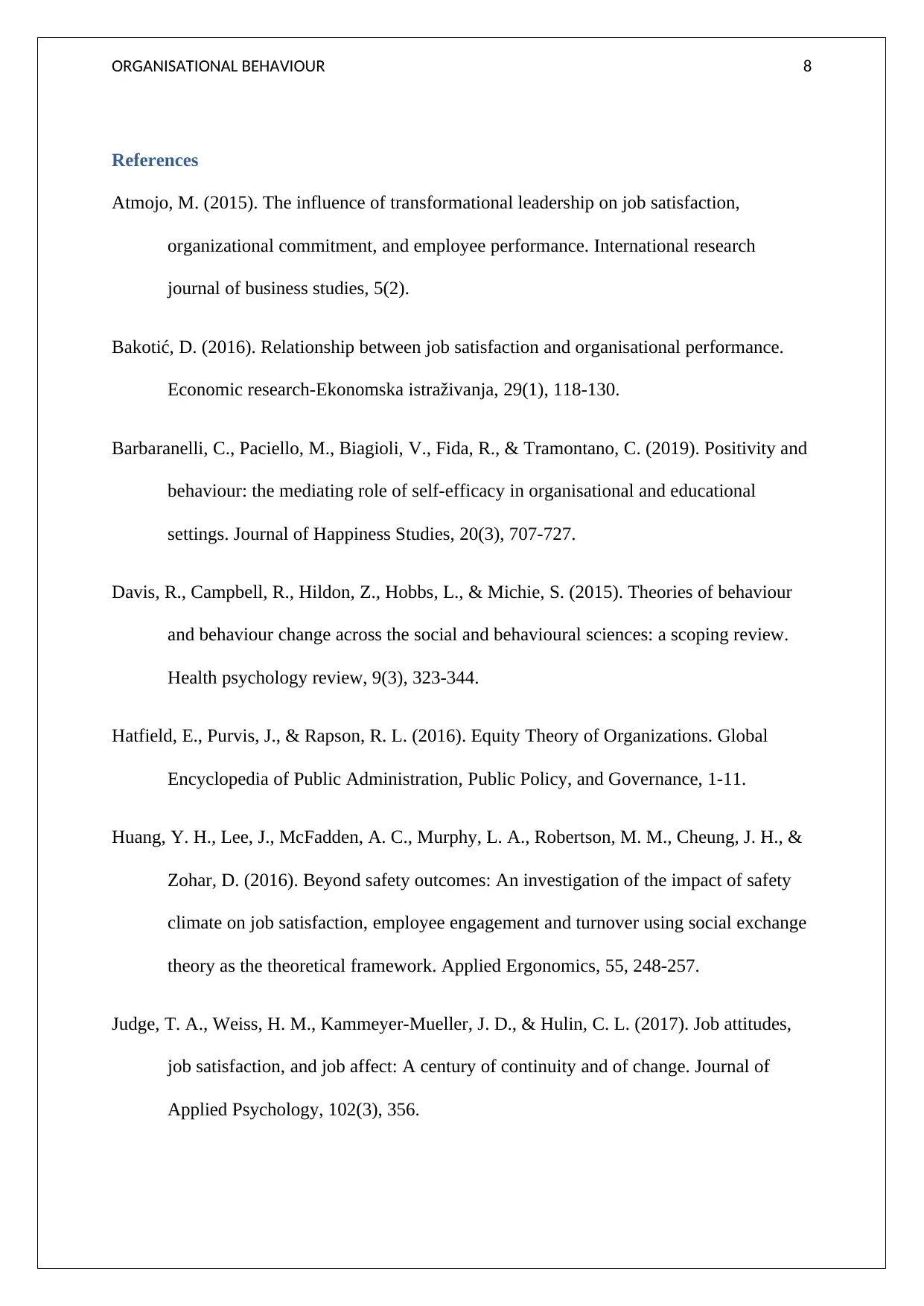
ORGANISATIONAL BEHAVIOUR 8
References
Atmojo, M. (2015). The influence of transformational leadership on job satisfaction,
organizational commitment, and employee performance. International research
journal of business studies, 5(2).
Bakotić, D. (2016). Relationship between job satisfaction and organisational performance.
Economic research-Ekonomska istraživanja, 29(1), 118-130.
Barbaranelli, C., Paciello, M., Biagioli, V., Fida, R., & Tramontano, C. (2019). Positivity and
behaviour: the mediating role of self-efficacy in organisational and educational
settings. Journal of Happiness Studies, 20(3), 707-727.
Davis, R., Campbell, R., Hildon, Z., Hobbs, L., & Michie, S. (2015). Theories of behaviour
and behaviour change across the social and behavioural sciences: a scoping review.
Health psychology review, 9(3), 323-344.
Hatfield, E., Purvis, J., & Rapson, R. L. (2016). Equity Theory of Organizations. Global
Encyclopedia of Public Administration, Public Policy, and Governance, 1-11.
Huang, Y. H., Lee, J., McFadden, A. C., Murphy, L. A., Robertson, M. M., Cheung, J. H., &
Zohar, D. (2016). Beyond safety outcomes: An investigation of the impact of safety
climate on job satisfaction, employee engagement and turnover using social exchange
theory as the theoretical framework. Applied Ergonomics, 55, 248-257.
Judge, T. A., Weiss, H. M., Kammeyer-Mueller, J. D., & Hulin, C. L. (2017). Job attitudes,
job satisfaction, and job affect: A century of continuity and of change. Journal of
Applied Psychology, 102(3), 356.
References
Atmojo, M. (2015). The influence of transformational leadership on job satisfaction,
organizational commitment, and employee performance. International research
journal of business studies, 5(2).
Bakotić, D. (2016). Relationship between job satisfaction and organisational performance.
Economic research-Ekonomska istraživanja, 29(1), 118-130.
Barbaranelli, C., Paciello, M., Biagioli, V., Fida, R., & Tramontano, C. (2019). Positivity and
behaviour: the mediating role of self-efficacy in organisational and educational
settings. Journal of Happiness Studies, 20(3), 707-727.
Davis, R., Campbell, R., Hildon, Z., Hobbs, L., & Michie, S. (2015). Theories of behaviour
and behaviour change across the social and behavioural sciences: a scoping review.
Health psychology review, 9(3), 323-344.
Hatfield, E., Purvis, J., & Rapson, R. L. (2016). Equity Theory of Organizations. Global
Encyclopedia of Public Administration, Public Policy, and Governance, 1-11.
Huang, Y. H., Lee, J., McFadden, A. C., Murphy, L. A., Robertson, M. M., Cheung, J. H., &
Zohar, D. (2016). Beyond safety outcomes: An investigation of the impact of safety
climate on job satisfaction, employee engagement and turnover using social exchange
theory as the theoretical framework. Applied Ergonomics, 55, 248-257.
Judge, T. A., Weiss, H. M., Kammeyer-Mueller, J. D., & Hulin, C. L. (2017). Job attitudes,
job satisfaction, and job affect: A century of continuity and of change. Journal of
Applied Psychology, 102(3), 356.
⊘ This is a preview!⊘
Do you want full access?
Subscribe today to unlock all pages.

Trusted by 1+ million students worldwide
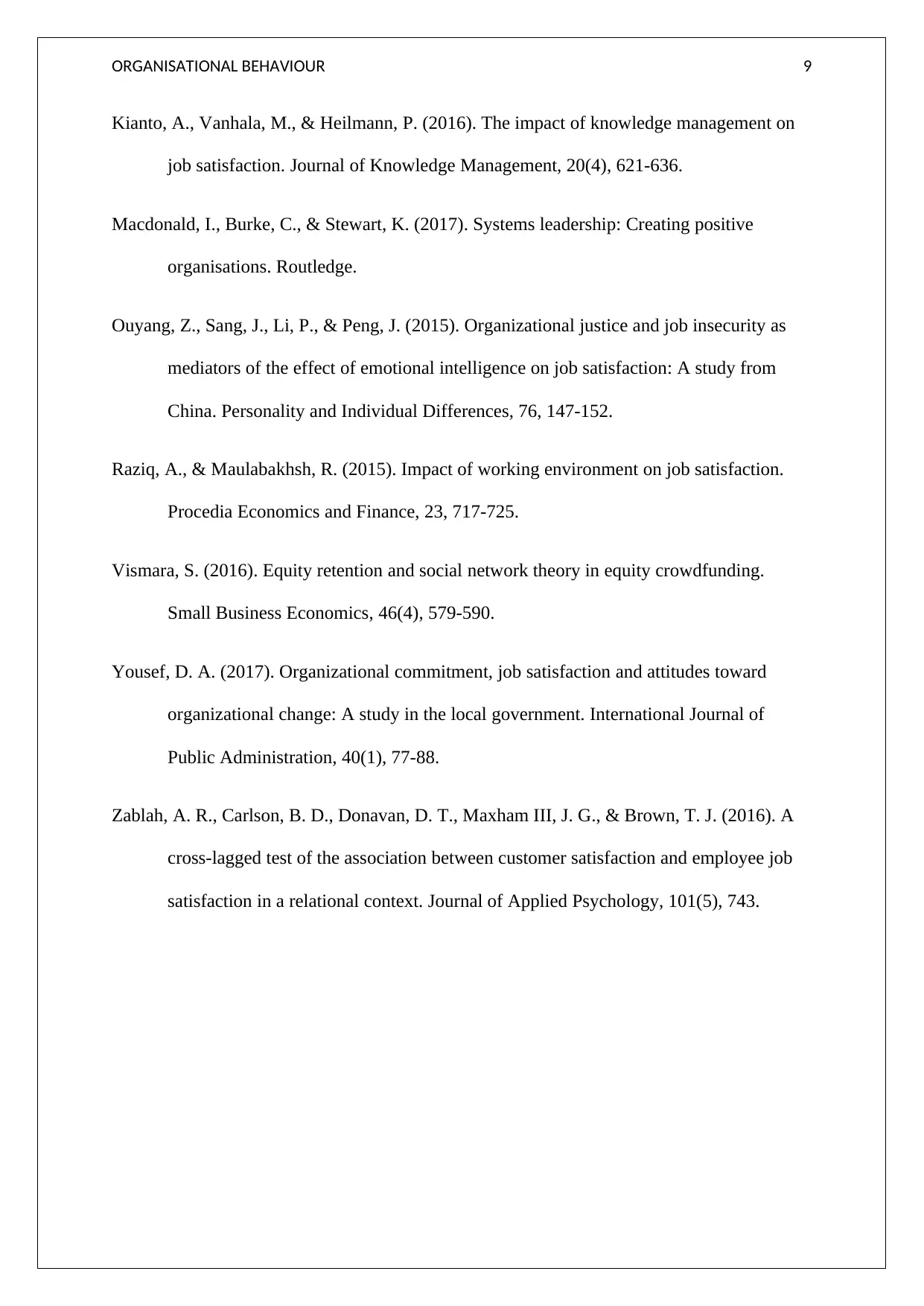
ORGANISATIONAL BEHAVIOUR 9
Kianto, A., Vanhala, M., & Heilmann, P. (2016). The impact of knowledge management on
job satisfaction. Journal of Knowledge Management, 20(4), 621-636.
Macdonald, I., Burke, C., & Stewart, K. (2017). Systems leadership: Creating positive
organisations. Routledge.
Ouyang, Z., Sang, J., Li, P., & Peng, J. (2015). Organizational justice and job insecurity as
mediators of the effect of emotional intelligence on job satisfaction: A study from
China. Personality and Individual Differences, 76, 147-152.
Raziq, A., & Maulabakhsh, R. (2015). Impact of working environment on job satisfaction.
Procedia Economics and Finance, 23, 717-725.
Vismara, S. (2016). Equity retention and social network theory in equity crowdfunding.
Small Business Economics, 46(4), 579-590.
Yousef, D. A. (2017). Organizational commitment, job satisfaction and attitudes toward
organizational change: A study in the local government. International Journal of
Public Administration, 40(1), 77-88.
Zablah, A. R., Carlson, B. D., Donavan, D. T., Maxham III, J. G., & Brown, T. J. (2016). A
cross-lagged test of the association between customer satisfaction and employee job
satisfaction in a relational context. Journal of Applied Psychology, 101(5), 743.
Kianto, A., Vanhala, M., & Heilmann, P. (2016). The impact of knowledge management on
job satisfaction. Journal of Knowledge Management, 20(4), 621-636.
Macdonald, I., Burke, C., & Stewart, K. (2017). Systems leadership: Creating positive
organisations. Routledge.
Ouyang, Z., Sang, J., Li, P., & Peng, J. (2015). Organizational justice and job insecurity as
mediators of the effect of emotional intelligence on job satisfaction: A study from
China. Personality and Individual Differences, 76, 147-152.
Raziq, A., & Maulabakhsh, R. (2015). Impact of working environment on job satisfaction.
Procedia Economics and Finance, 23, 717-725.
Vismara, S. (2016). Equity retention and social network theory in equity crowdfunding.
Small Business Economics, 46(4), 579-590.
Yousef, D. A. (2017). Organizational commitment, job satisfaction and attitudes toward
organizational change: A study in the local government. International Journal of
Public Administration, 40(1), 77-88.
Zablah, A. R., Carlson, B. D., Donavan, D. T., Maxham III, J. G., & Brown, T. J. (2016). A
cross-lagged test of the association between customer satisfaction and employee job
satisfaction in a relational context. Journal of Applied Psychology, 101(5), 743.
1 out of 10
Related Documents
Your All-in-One AI-Powered Toolkit for Academic Success.
+13062052269
info@desklib.com
Available 24*7 on WhatsApp / Email
![[object Object]](/_next/static/media/star-bottom.7253800d.svg)
Unlock your academic potential
© 2024 | Zucol Services PVT LTD | All rights reserved.





